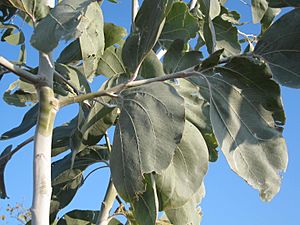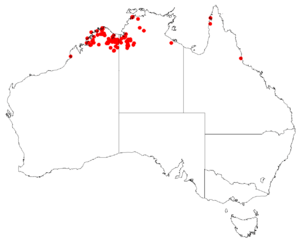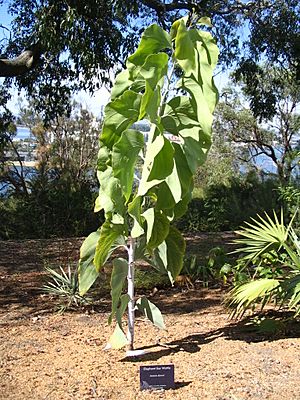Elephant ear wattle facts for kids
Quick facts for kids Elephant ear wattle |
|
|---|---|
 |
|
| Scientific classification | |
| Genus: |
Acacia
|
| Species: |
dunnii
|
 |
|
| Occurrence data from AVH | |
| Synonyms | |
|
Acacia sericata var. dunnii Maiden |
|
The Elephant Ear Wattle (Acacia dunnii) is a unique shrub or small tree. It is also known as Dunn's Wattle. This plant is part of the Acacia family, which includes many types of wattles.
What's in a Name?
The name dunnii was chosen to honor Edward John Dunn. He was a government geologist for Victoria from 1904 to 1912.
Local Aboriginal people have their own names for this plant. In the Jaminjung and Nungali languages, it is called Bawaya. In the Ngarinyman language, it is known as Barrawi.
What Does It Look Like?
This small shrub or tree can grow to be about 1.5 to 6 meters (5 to 20 feet) tall. It can also spread out to be 2 to 4 meters (7 to 13 feet) wide. It usually has just one main stem.
The Elephant Ear Wattle has beautiful silvery-blue leaves. These leaves are called phyllodes. They are quite large, measuring 20 to 45 centimeters (8 to 18 inches) long. They can also be 6 to 16 centimeters (2 to 6 inches) wide. These large leaves hang down from the branches.
This plant blooms with yellow flowers from January to June. The flowers grow in round clusters, like little balls. Each flower cluster is about 8 to 15 millimeters (0.3 to 0.6 inches) across.
After the flowers, brown, woody seed pods appear. These pods are flat and can be slightly curved. They are 6 to 14.5 centimeters (2 to 6 inches) long. They are also 2.4 to 3 centimeters (1 to 1.2 inches) wide.
How Scientists Classify It
A botanist named William Bertram Turrill officially described this plant in 1922. He published his findings in a work called Dunn's Wattle.
Sometimes, plants can have different scientific names over time. For example, the Elephant Ear Wattle was also called Racosperma dunnii by Leslie Pedley. It was also known as Acacia sericata var. dunnii by Joseph Maiden. These are called synonyms.
Where Does It Grow?
The Elephant Ear Wattle is native to certain parts of Australia. You can find it in the Northern Territory and the Kimberley region of Western Australia.
It often grows on shallow, sandy soils. These soils are usually found over sandstone or quartzite rock. You might see it on ridges, stony hills, or among rocks and rocky outcrops.
Even though it has been seen in Queensland, experts believe it is not native there. Instead, it has become naturalized, meaning it started growing there on its own after being introduced.


